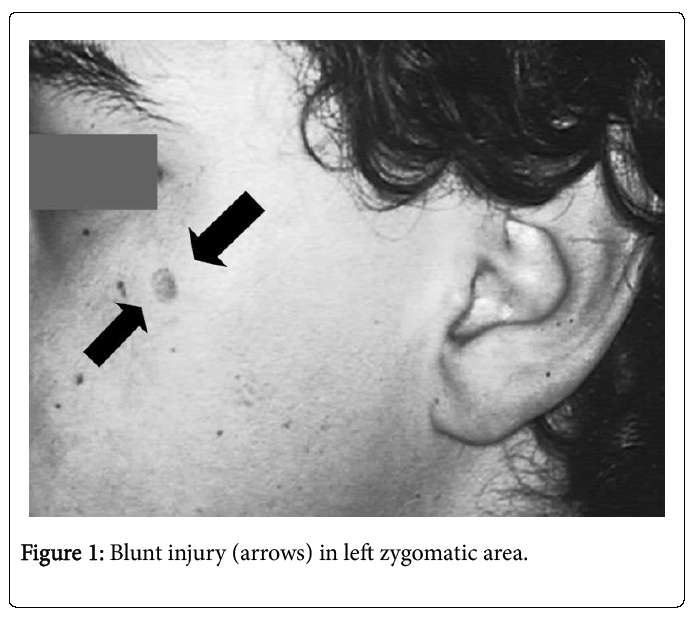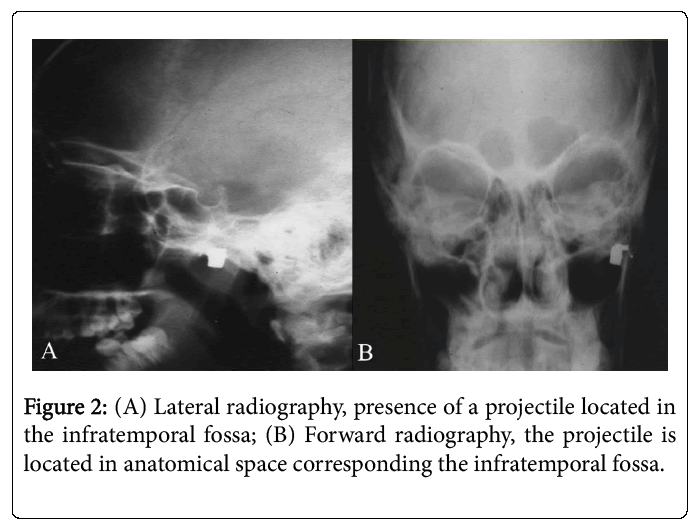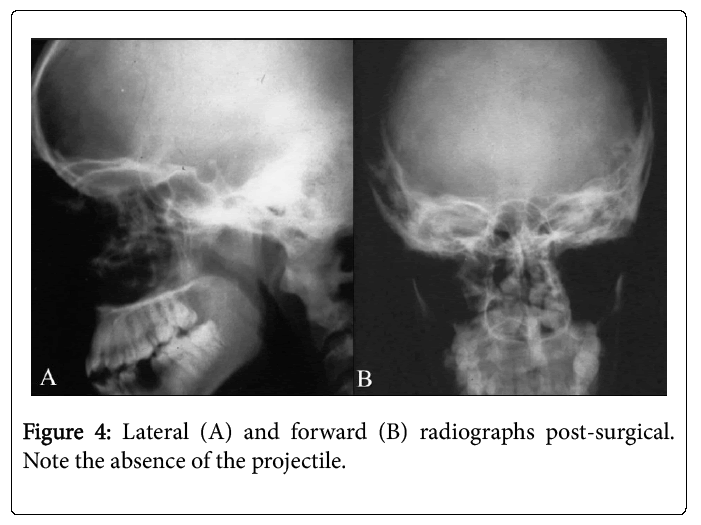Case Report Open Access
A Rare Case of Surgical Treatment of Projectile in the Infratemporal Fossa
Grossmann Eduardo1*, Bruno Primo2, Luciano Ambrosio Ferreira3 and Antônio Carlos Pires Carvalho4 and Molander U41Craniofacial Pain Applied to Dentistry Discipline, Federal University of Rio Grande do Sul and Pain and Orofacial Deformity Center, CENDDOR, Porto Alegre, Brazil
2Department of Oral and Maxillofacial Surgery, School of Dentistry, ULBRA, Canoas, RS, Brazil
3Maternity Hospital Therezinha Jesus-HMTJ/JF and Supreme-Faculty Medical and Health Sciences. Juiz de Fora, MG, Brazil
4Department of Radiology, Postgraduate Program in Medicine, Federal University of Rio de Janeiro
- *Corresponding Author:
- Eduardo Grossmann
Street Royal Court, 513, Porto Alegre
Rio Grande do Sul, Brazil
Tel: 55 (51) 3331-4315
E-mail: edugdor@gmail.com
Received Date: December 03, 2015; Accepted Date: September 20, 2016; Published Date: September 23, 2016
Citation: Eduardo G, Primo B, Ferreira LA, Carvalho ACP (2016) A Rare Case of Surgical Treatment of Projectile in the Infratemporal Fossa. J Palliat Care Med 6:286. doi: 10.4172/2165-7386.1000286
Copyright: © 2016 Eduardo G, et al. This is an open-access article distributed under the terms of the Creative Commons Attribution License, which permits unrestricted use, distribution, and reproduction in any medium, provided the original author and source are credited.
Visit for more related articles at Journal of Palliative Care & Medicine
Keywords
Wound ballistics; Infratemporal fossa; Rehabilitation; Temporomandibular joint
Introduction
It is difficult to calculate the actual incidence of facial injuries by firearms. In a retrospective study of about gunshot wounds, 6,9% of injuries affected the face [1]. The majority of maxillofacial gunshot wounds are caused by suicide attempts, which young men are most often affected.
The facial gunshot victim should be transported to a trauma center equipped to deal with maxillofacial and neurosurgery because 40% require emergency surgery [2].
Injuries caused by firearms can have fatal results. Even if the bullet did not cause great damage to the soft and hard tissues other serious problems can occur. Sometimes, the fragment becomes encapsulated and only the follow-up is necessary [3]. However, elevated serum levels of Lead (Pb) were detected in patients with retained projectiles.
The clinical relevance of this finding is not clear, although patients, especially children, need to care about the symptoms of poisoning and the need for long-term monitoring.
Furthermore, the retained bullets may cause infections, which can lead to meningitis if the object is located near the base of the skull [4].
Because of neurological and vascular complications, it is important the exact location of the fragment and to define which surgical approach to remove the projectiles is more appropriate.
The aim of this paper is to report the case of a projectile located in the left infratemporal fossa, discuss surgical treatment, its risks and complications, since this situation is rarely described in the literature.
Case report
The patient, an 18 year old man, sought for treatment ten days after being shot by a projectile caliber 22. During anamnesis, the patient reported pain, limited mouth opening and and prejudice in motion right laterality.
The physical exam revealed a perforated-contusion lesion in the left zygomatic area (Figure 1). The measuring of mouth opening was 20.01mm. The patient presented neither sensorial, autonomic nor motor impairment.
The lateral and forward radiography show the projectile located medial to the left mandibular condyle (Figure 2 A and B) within the infratemporal fossa.
Based on the signs, symptoms and images, a surgery, aiming at the removal of the projectile, was proposed and the patient accepted the treatment.
The patient underwent general anesthesia with right sided nasotracheal intubation. Further, antisepsis with 2% chlorhexidine and apposition of the surgical area were performed, with the ear and the lateral corner of the eye visible and acoustic meatus tamponed with gauze. The preauricular area was stained with methylene blue to asepsis and then, the area was underwent c with 2% lidocaine chlorhydrate with vasoconstrictor (1:100000). Skin and conjunctive tissue were incised toward the superficial layer of the temporal fascia, the superficial temporal vessels and nerve auriculotemporal retracted earlier in retail. It is incised obliquely temporal fascia in anteroposterior direction from the zygomatic arch.
Then, the deep dissection to visualize the surface of the temporomandibular ligament, capsule and palpate to the articular eminence was done, all structures were preserved. A second horizontal incision in the anterior direction occurred from the eminence against the zygomatic arch. Now, the dissection was performed with periosteum elevator toward lower, reaching the upper head of the lateral pterygoid muscle. It was continued with the same instrument, in anterior and inferior direction in order to locate the lower head of this muscle. Carefully, the region between the two heads was explored with Matzenbauer scissors, aiming to minimize the chances of achieving the maxillary artery and to locate the projectile. With the help of an anatomical clamp Halsted, the bullet was removed (Figure 3). The closure of the layers was performed from inside to outside with Vycril 4/0 resorbable thread. The skin was closed with continuous 6/0 Polypropilene (Prolene) and protected with a gauze overlay. The suture was removed at intervals from the 5th to the 7th postoperative day.
The postoperative occurred without complications and the patient began physiotherapy 7 days after leaving hospital. The physiotherapy sessions happened twice a week for three months and the patient underwent ultrasound treatment, 1.5 w/cm2 on the left area for 5 minutes. It was associated with wooden spatulas, moist hot towels and passive stretching exercises for opening, closing and lateral jaw movement. A new radiographic exam show the projectile is no longer there (Figure 4 A and B). The patient presented neither sensorial autonomic or motor impairment. The follow up revealed that the patient presented mouth opening of 40.02 mm and no pain.
Discussion
The infratemporal fossa is the anatomical sequence of the temporal fossa region5. It is located between the medial surface of the zygomatic bone and the lateral surface of the temporal bone, the major wing of the sphenoid bone and ramus of mandible. Structures with great importance are present, as lateral and medial pterygoid muscle, the maxillary artery, which may be superficial or deep below the head from side ptrerygoid muscle, the pterygoid venous plexus, the otic ganglion, the cord of tympani nerve, the mandibular nerve and one of its branches, the lingual nerve. In this case related, the surgery was indicated because the movement function was limited due bullet presence and the local edema between the two heads of the lateral pterygoid muscle left. As performed jaw movements had pain on opening the mouth and jaw laterality right.
The literature reports that the head and face are common sites of gunshot injury6. Usually, it produces major deformity and functional impairment, particularly when the temporomandibular joint or the facial nerve is damaged. Complications may include mandibular displacement, limited mouth opening, limited lateral movement of the jaw, anterior open bite, and temporomandibular ankylosis [6]. Other complications and risks could occur if surgical and clinical measures were not imposed: arteriovenous damage involving the pterygoid venous plexus and / or maxillary artery; fibrosis of one or both heads of this muscle, which could develop into a fibrous ankylosis; or bone and infection; change in saliva production by the parotid, submandibular and sublingual; reduction or absence of taste in the anterior 2/3 of the tongue; hypoesthesia of the leading edge and side of the tongue; and pain in the pronunciation. Front to the therapy there were no such risks and complications. If the projectile was lodged in a hard or soft tissue structure and did not cause pain or dysfunction a more conservative clinical approach would be chosen, one that could be associated to physiotherapy [7].
The pre-auricular surgical approach was chosen because it allows adequate local exposure, with great view of the region, aesthetically acceptable and low risk of facial nerve injury [5]. Despite of choice of such surgical approach gave difficulty locating the projectile between the two heads of the lateral pterygoid muscle and dissect them, because this muscle is located deep to the skin with different provisions about its anatomical and the number of heads, which can vary from two to three [5]. The imaging exam was not the most appropriate, once that computed tomography would be ideal to evaluate the foreign object place and such muscle. Another problem in the surgical was malfunctioning image intensifier hindering the location of the projectile.
Throughout the arthrotomy, regardless of access that takes place - endaural, preauricular, post-auricular - there is a possibility of damaging the facial nerve, mainly temporal branch and less often the zygomatic branch and auriculotemporal nerve [5,6]. In this case reported, there was no motor, sensory or autonomic damage noted during the follow-up.
The use of endoscopy has increased in recent years because it allows surgeons to get access to different areas of the human body with less exposure of tissues during dissection, reducing the morbidity compared with an open surgical approach8. Neff et al., [8] have successfully removing a bullet of the infratemporal fossa by endoscopy with intraoral access. In the present case was not used endoscope due to the absence of such equipment in hospital level and the inexperience of the surgical team in handling such a technique.
Others techniques for obtaining images have been described for locating projectiles and foreign bodies. Ultrasound image, computed tomography, cone beam computed tomography and C-arm techniques allow air gun pellets to be accurately localized [9]. However, these devices are expensive and usually not available. Radiographic localization techniques obtained by exposure of different plains or views of angles allow positioning the researched object in 3 dimensions [9]. In this case, other imaging features were not available in the hospital.
The physiotherapy prescribed after surgery, with ultrasound therapy and superficial heat aimed to restore the proper functioning of the joint, relieving the pain, reducing the edema, promoting neuromuscular reeducation of the masticatory muscles, inhabiting the contracture process and adhesion or adhesiveness formation and facilitating condylar movement [10]. We have also prescribed therapeutic exercises with spatulas to wider the amplitude of the movements and to restore the proprioceptive conditions.
Conclusion
The removal of the projectile with the preauricular approach and the combined physiotherapy treatment provided in the reestablishment of the joint function, pain elimination, an appropriate mouth opening and no motor or sensory sequel of the face.
References
- Norris O, Mehra P, Salama A (2015) Maxillofacial Gunshot Injuries at an Urban Level I Trauma Center-10-Year Analysis. J Oral MaxillofacSurg 73: 1532-1539.
- Maurin O, de Régloix S, Dubourdieu S, Lefort H, Boizat S, et al. (2015) Maxillofacial gunshot wounds. Prehosp Disaster Med 3: 1-4.
- Farrell SE, Vandevander P, Schoffstall JM, Lee DC (1999)Blood lead levels in emergency department patients with retained lead bullets and shrapnel. AcadEmerg Med 6:208-212.
- Brinson GM, Senior BA, Yarbrough WG (2004) Endoscopic management of retained airgun projectiles in the paranasal sinuses. Otolaryngol Head Neck Surg130: 25-30.
- Isolan GR, Rowe R, Al-Mefty O (2007) Microanatomy and surgical approaches to the infratemporal fossa: an anaglyphic three-dimensional stereoscopic printing study. Skull Base 17:285-302.
- Pires MS, Giongo CC, AntonelloGde M, Couto RT, Filho R de O, et al. (2015) An interesting case of gunshot injury to the temporromandibular joint. Craniomaxillofac Trauma Reconstr. 8: 79-82.
- Oh DW, Kim KS, Lee GW (2002) The effect of physiotherapy on post-temporomandibular joint surgery patients. J Oral Rehabil29:441-446.
- Neff LL, Liess BD, Chang CW (2008) Transoral endoscopic removal of a bullet from the infratemporal fossa. Otolaryngol Head Neck Surg138:113-114.
- Daghfous A, Bouzaïdi K, Abdelkefi M, Rebai S, Zoghlemi A, et al. (2015) Contribution of imaging in the initial management of ballistic trauma. DiagnInterv Imaging 96:45-55.
- Stockmann P, Vairaktaris E, FennerM,TudorC,NeukamFW, et al. (2007) Conventional radiographs: are they still the standard in localization of projectiles? Oral Surg Oral Med Oral Pathol Oral RadiolEndod104:71-75.
Relevant Topics
- Caregiver Support Programs
- End of Life Care
- End-of-Life Communication
- Ethics in Palliative
- Euthanasia
- Family Caregiver
- Geriatric Care
- Holistic Care
- Home Care
- Hospice Care
- Hospice Palliative Care
- Old Age Care
- Palliative Care
- Palliative Care and Euthanasia
- Palliative Care Drugs
- Palliative Care in Oncology
- Palliative Care Medications
- Palliative Care Nursing
- Palliative Medicare
- Palliative Neurology
- Palliative Oncology
- Palliative Psychology
- Palliative Sedation
- Palliative Surgery
- Palliative Treatment
- Pediatric Palliative Care
- Volunteer Palliative Care
Recommended Journals
- Journal of Cardiac and Pulmonary Rehabilitation
- Journal of Community & Public Health Nursing
- Journal of Community & Public Health Nursing
- Journal of Health Care and Prevention
- Journal of Health Care and Prevention
- Journal of Paediatric Medicine & Surgery
- Journal of Paediatric Medicine & Surgery
- Journal of Pain & Relief
- Palliative Care & Medicine
- Journal of Pain & Relief
- Journal of Pediatric Neurological Disorders
- Neonatal and Pediatric Medicine
- Neonatal and Pediatric Medicine
- Neuroscience and Psychiatry: Open Access
- OMICS Journal of Radiology
- The Psychiatrist: Clinical and Therapeutic Journal
Article Tools
Article Usage
- Total views: 11055
- [From(publication date):
September-2016 - Apr 02, 2025] - Breakdown by view type
- HTML page views : 10219
- PDF downloads : 836




